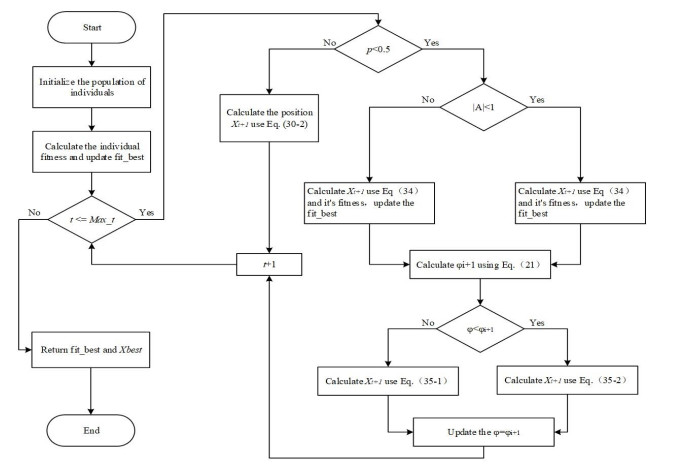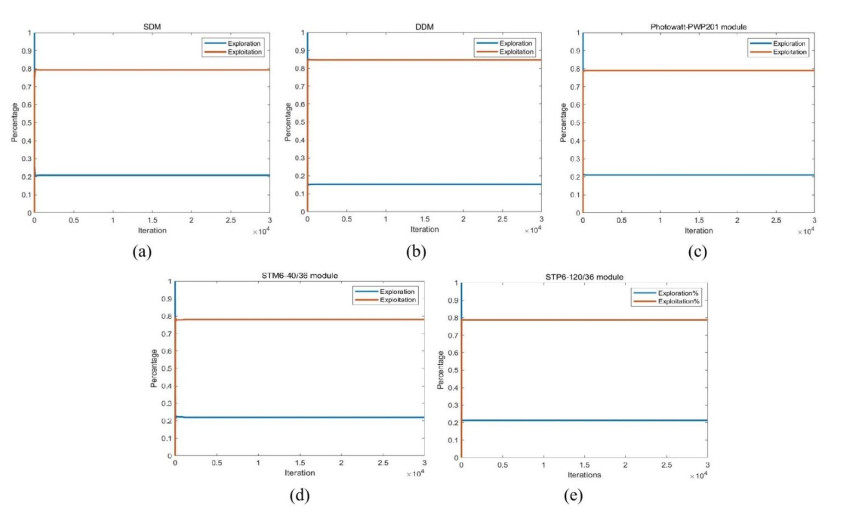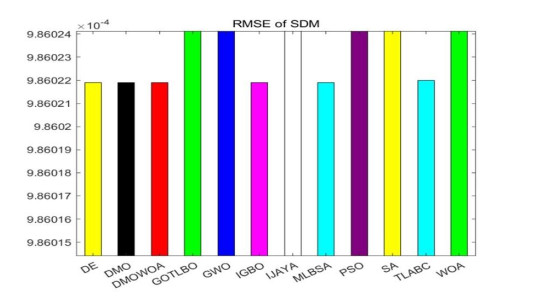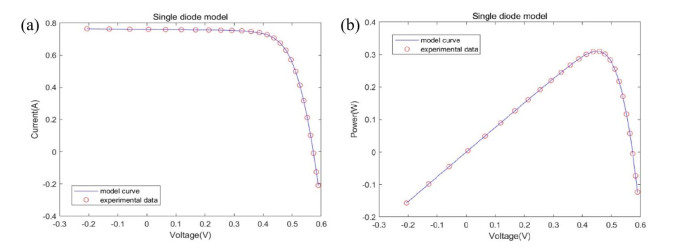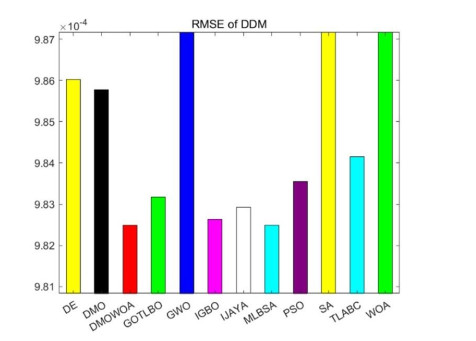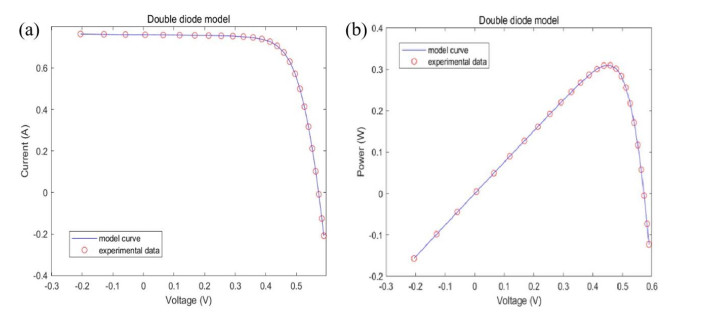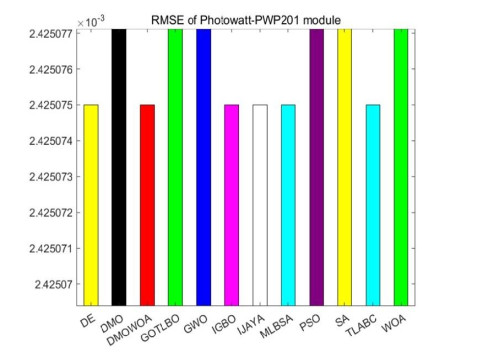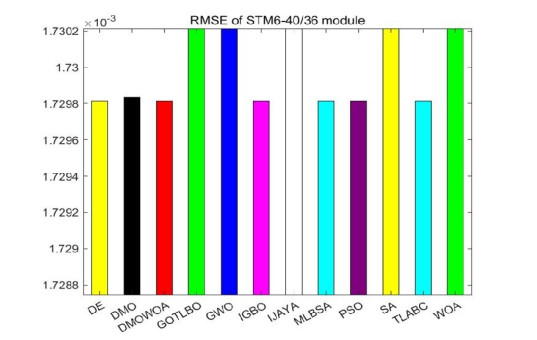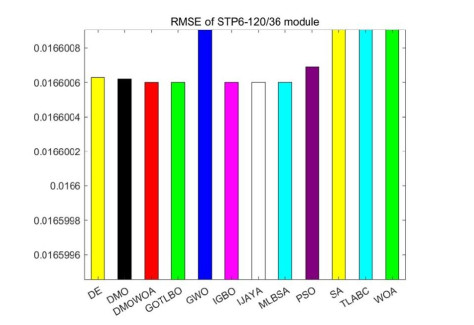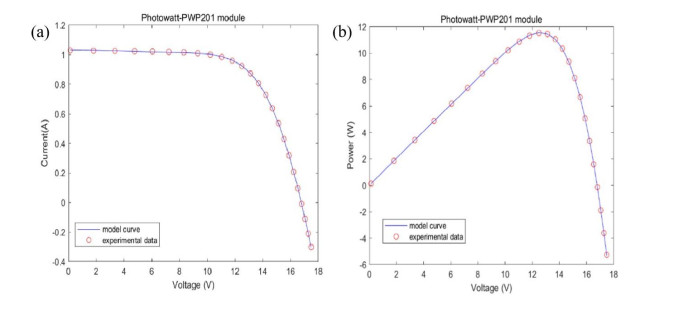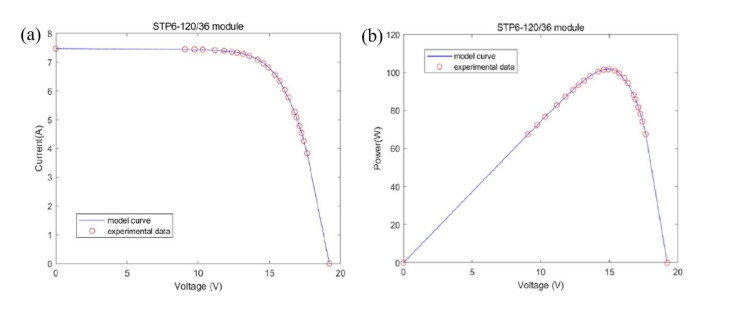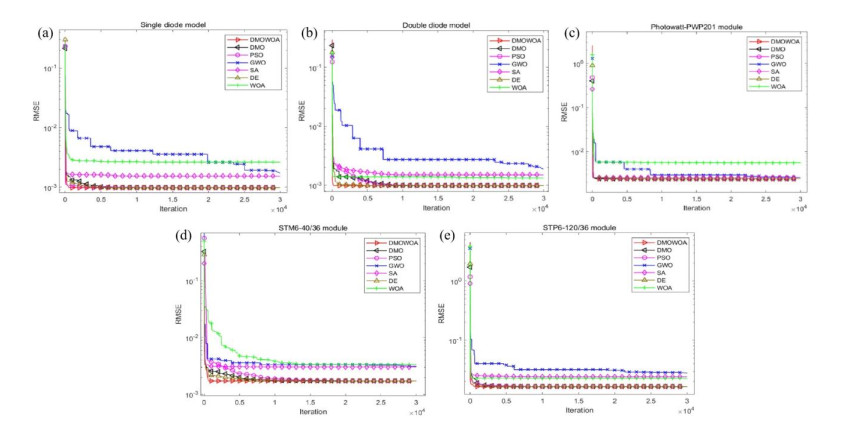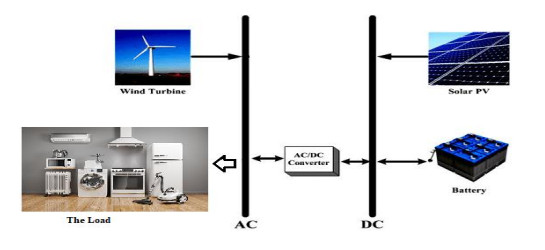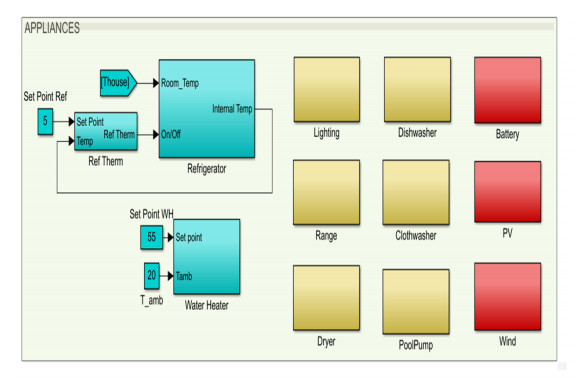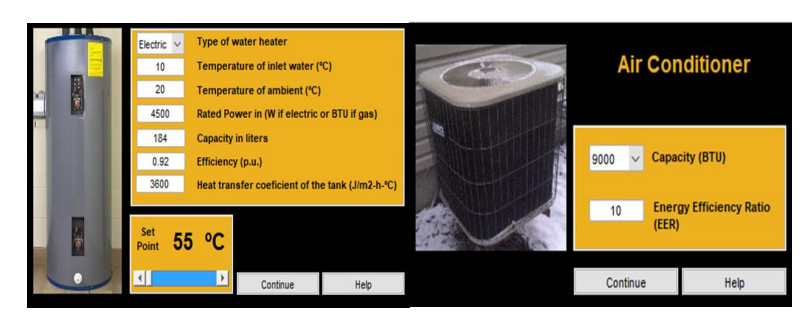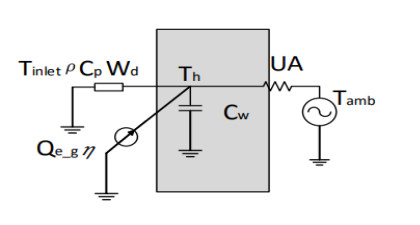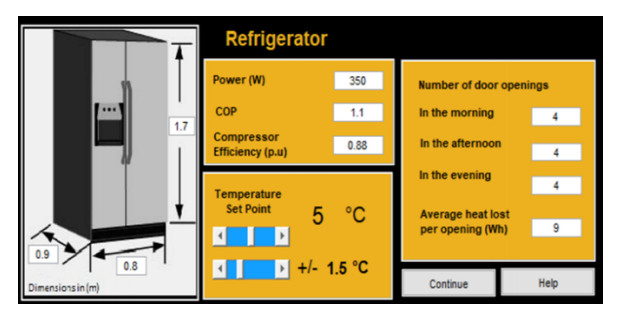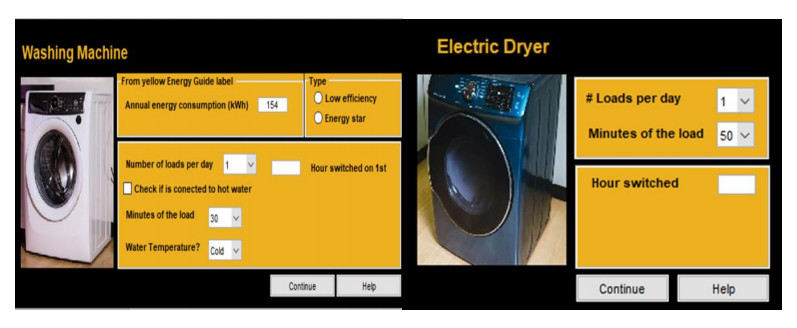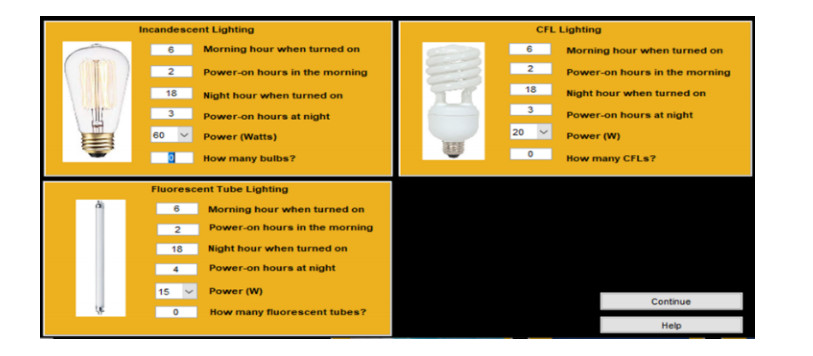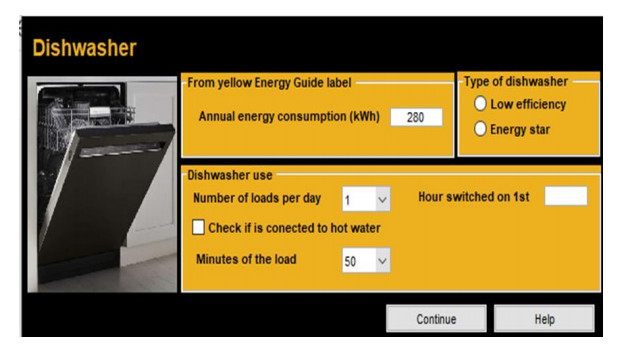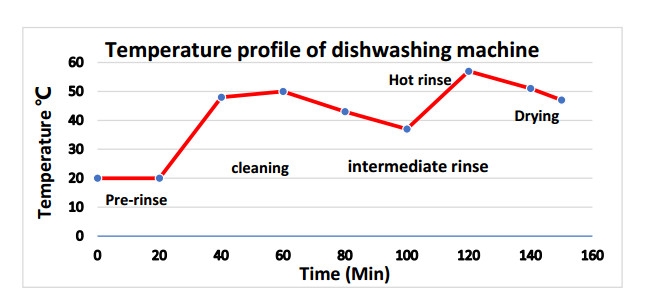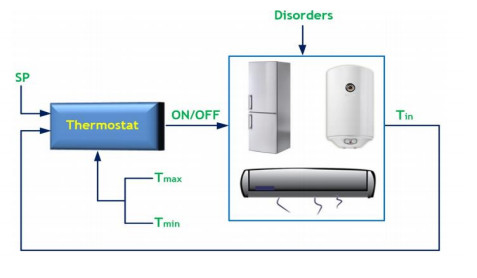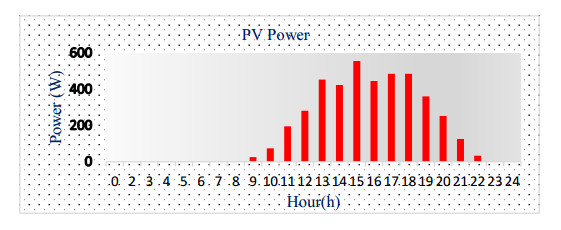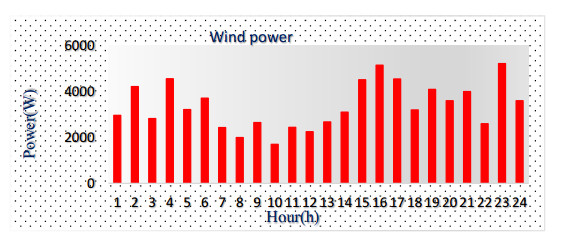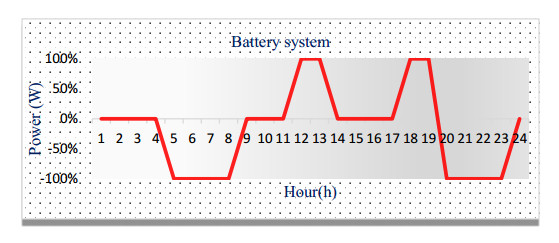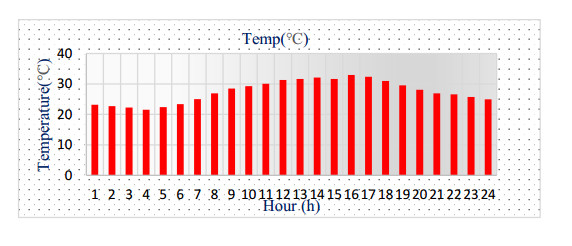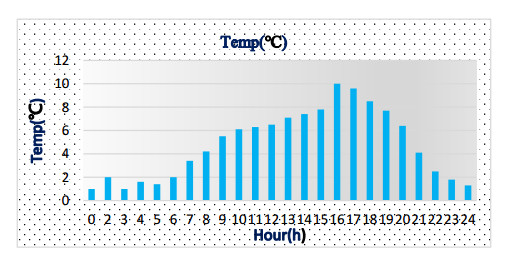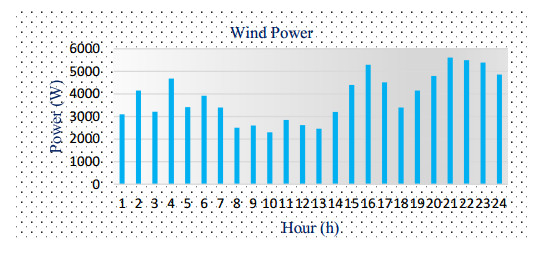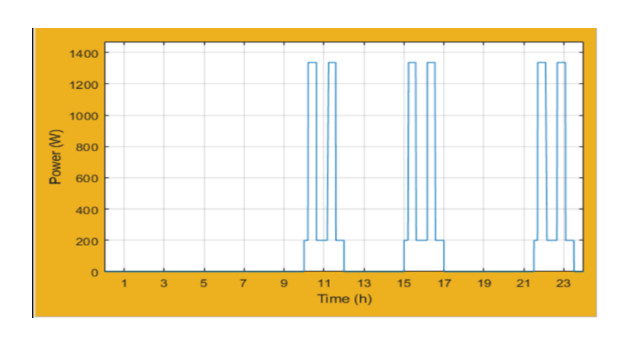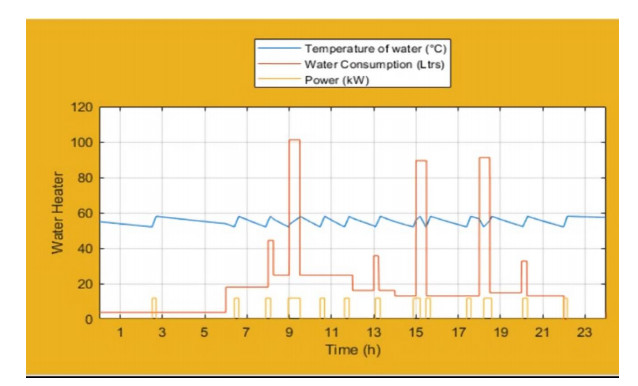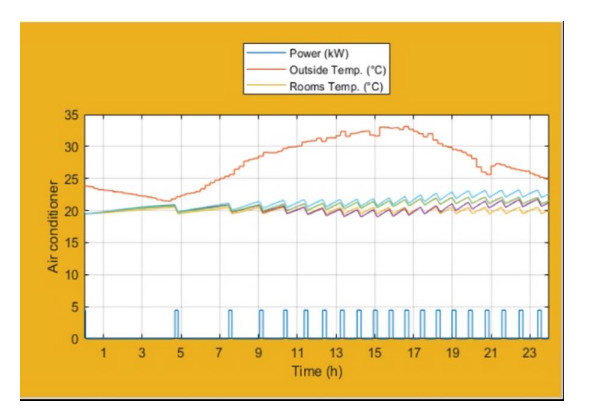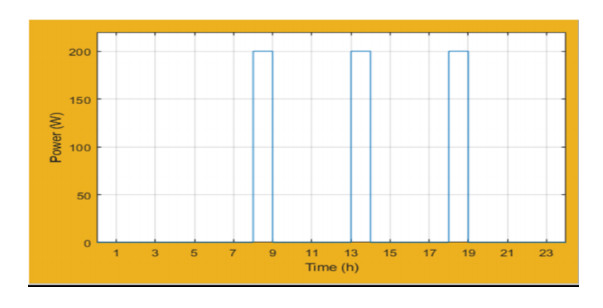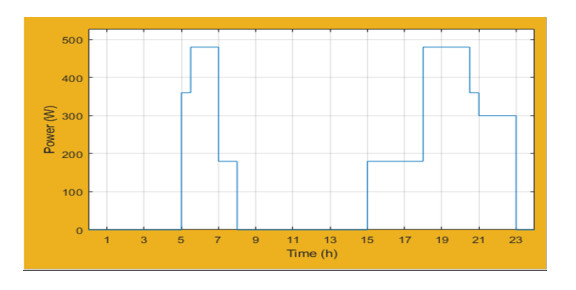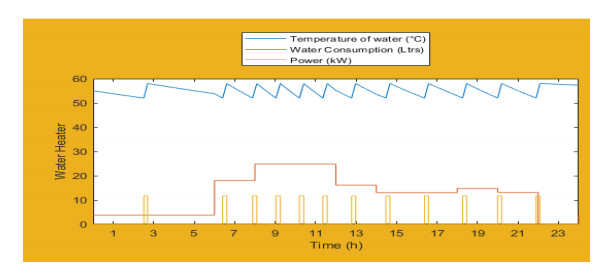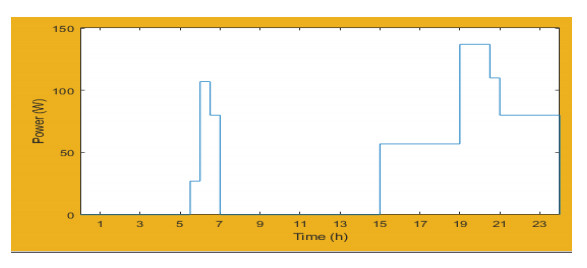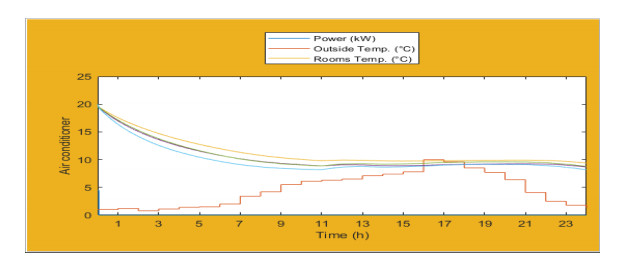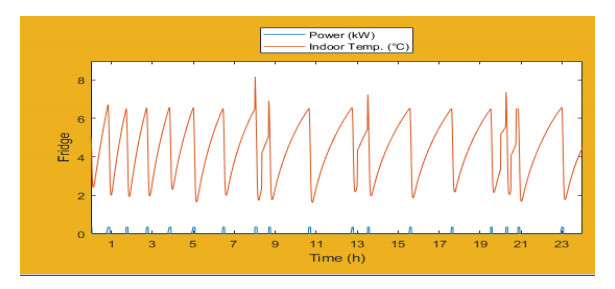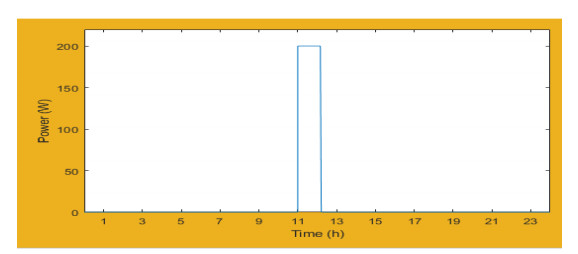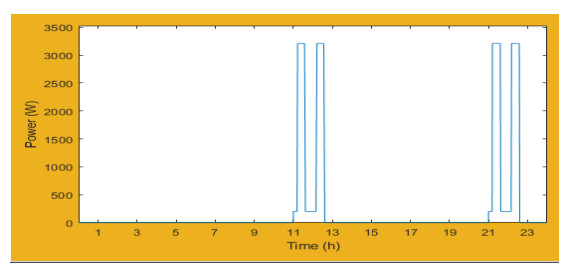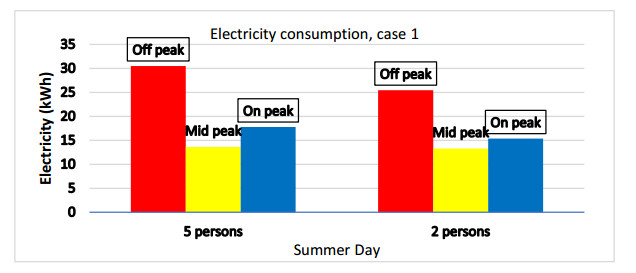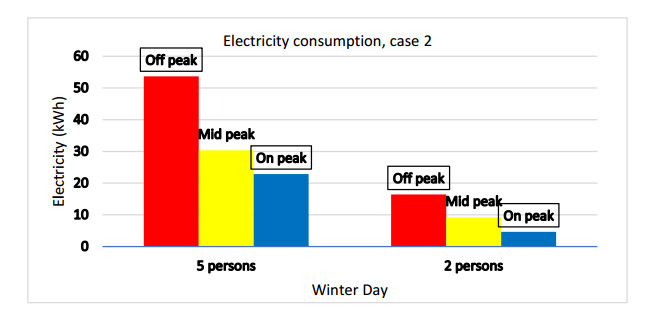1.
Introduction
In consideration of the increasingly severe energy crisis and environmental pollution, renewable energy has garnered significant attention and recognition [1]. The renewable and emission-free characteristics of solar energy have garnered extensive attention, rendering it a subject of great significance in the academic community [2,3]. The photovoltaic system, serving as a solar energy-to-electricity conversion system, assumes a pivotal role within the power grid [4]. For the PV models [5], the single-diode and double-diode models are the most frequently employed in practice. The design and evaluation of photovoltaic systems rely heavily on the precision of parameters such as current and resistance, which play a pivotal role [6]. The photovoltaic parameter extraction is performed within a simulated operational environment of an authentic photovoltaic system, where the current-voltage data is measured under all operational conditions of the actual photovoltaic system [7,8]. Therefore, it is extremely significant to extract PV model parameters accurately, quickly, and reliably.
In recent years, photovoltaic parameter extraction has emerged as a prominent research area, with numerous optimization methods proposed to address this issue [9]. These methods are analytical methods [10] and numerical approaches [11]. The implementation of analytical methods is straightforward, involving the analysis of mathematical equations to address problems. However, analytical methods heavily rely on selected values and inaccurate choices can result in flawed models. The field of numerical methods can be categorized into deterministic approaches and metaheuristic algorithms. Deterministic methods, such as the Newton-Raphson method [12], Lambert W function [13], Gauss-Seidel method [14], and iterative curve fitting [15], are commonly employed. Deterministic methods exhibit excessive reliance on initial values and are prone to falling into local optima. Metaheuristic algorithms are a general class of heuristic algorithms that do not rely on domain-specific knowledge but provide a general framework for searching the solution space of a problem to find an approximately optimal solution. Metaheuristic algorithms often meet some requirements of the search process, and then the heuristic algorithm implemented according to these requirements is called a metaheuristic algorithm. Many metaheuristic algorithms are inspired by some random phenomena in nature. Metaheuristic methods exhibit flexibility in the objective function and initial values, making them easily implementable. The inspiration for the mutation, crossover, and selection strategies of differential evolution comes from the theory of evolution in nature. Chaotic local search based differential evolution algorithms use the chaotic local search (CLS) mechanism to avoid premature convergence of evolutionary algorithms [16]. The non-dominated evolutionary optimization strategy based on covariance matrix adaptation (CMA-ES) is an evolutionary optimization strategy aimed at reducing the number of iterations required to converge to the optimal solution [17]. The Bayesian optimization framework is an excellent algorithm that considers heteroscedastic noise to adjust hyperparameters in control problems [18]. Consequently, metaheuristic algorithms find extensive applications in optimization problems across diverse domains. Numerous scholars have employed meta-heuristic techniques for addressing the challenge of parameter extraction in photovoltaic modeling, such as genetic algorithm (GA) [19], differential evolution (DE) [20], particle swarm optimization (PSO) [21], simulated annealing algorithm (SA) [22], moth-flame optimization [23], artificial bee colony algorithm (ABC) [24], teaching-based optimization algorithm (TLBO) [25], JAYA [26], etc. Many scholars have proposed improved algorithms to solve this problem, as reviewed below.
In [27], an improved PSO incorporating a cross-sorting and dynamic population reduction strategy is proposed for extracting photovoltaic parameters. In [28], an improved PSO based on an adaptive mutation strategy is proposed, which can avoid premature phenomena and accurately extract photovoltaic parameters. In [29], an improved DE to identify photovoltaic parameters under all conditions. In [30], a hybrid algorithm of DE/WOA is proposed, which combines exploration of DE and exploitation of WOA and can accurately extract photovoltaic parameters. In [31], a novel formulation is proposed for the computation of the scale factor and crossover rate, thereby enhancing the performance of adaptive differential evolution through its implementation. In [32], the present study proposes a novel teaching-learning-based artificial bee colony algorithm, which combines the advantages of the teaching-learning-based optimization algorithm and the artificial bee colony algorithm, aiming to effectively extract photovoltaic parameters. In [33], an enhanced and simplified teach-learn optimization algorithm (STLBO) is proposed for parameter identification in proton exchange membrane (PEM) fuel cells and photovoltaic models. In [34], introduces a novel approach, namely the generalized oppositional teaching-learning-based optimization, for parameter extraction of photovoltaic models. In [35], an improved JAYA algorithm is proposed to effectively identify the parameters of a PV mode. In [36], the individual is quantified by probability, and then the evolutionary strategy is selected adaptively based on probability. A performance-guided JAYA is proposed to identify PV parameters. In [37], for accurate extract photovoltaic parameters, a multiple learning backtracking search algorithm is proposed. In [38], a memory-based improved gorilla troop optimizer is proposed, incorporating the exploration gorilla adaptive mutation mechanism (EGAMM) and gorilla memory saving technology. This algorithm effectively parameters the identification of photovoltaic models. In [39], introduces an enhanced whale optimization algorithm that incorporates two prey search strategies for precise extraction of photovoltaic parameters. In [40], introduces a novel chaotic whale optimization algorithm, which primarily employs chaotic mapping techniques to automatically compute and adapt internal parameters. This algorithm is effective in the precise extraction of photovoltaic parameters. In [41], proposes an improved pigeon-inspired optimization (PIO) algorithm based on the Taguchi method for the extraction of photovoltaic parameters. Simulation results show that the proposed algorithm is superior to the comparison algorithm. In [42], a two-phase quasi-affine transformation evolution with feedback (tfQUATRE) algorithm was proposed to extract PV parameters. This algorithm improves the ability of exploration and development by adjusting the search trend in different stages. Using historical populations as a form of feedback to guide the search for promising areas, maintain population diversity, and improve exploration ability. The experimental results show that the algorithm has strong competitiveness. In [43], propose a scale-free network-based differential evolution method. This method is based on the scale-free network-based population structure and a mutation operator that utilizes the neighborhood information provided by the scale-free structure. The experimental results indicate that this method can efficiently and reliably extract photovoltaic parameters. In [44], propose a differential evolution variant (PDcDE) to tackle the parameter estimation of solar PV models. This method uses an auto-controlled population strategy to adjust the population size during a search process, setting the diversity control parameters for determining the scaling factor and avoiding local optima through reverse search. In [45], a directional permutation differential evolution algorithm (DPDE) is proposed to tackle the parameter estimation of several kinds of solar PV models. DPDE utilizes the information generated by the search population and differential vector direction and has a strong global search ability to jump out of local optima.
These methods play a crucial role in PV model parameter extraction. However, owing to the multimodal characteristics inherent in the PV model, numerous existing methodologies are susceptible to encountering local optima during the parameter extraction process. There is still significant potential for enhancing the convergence speed and accuracy, particularly in the double diode model (DDM). Therefore, additional exploration of alternative methods is necessary for effective PV model parameter extraction.
The term "hybrid technology" refers to the amalgamation of two or more algorithms, harnessing their respective strengths to yield a novel algorithm that outperforms any single algorithm [46]. According to hybrid technology, the present study proposes a hybrid algorithm integrating dwarf mongoose optimization algorithm (DMO) and WOA. Dwarf mongoose optimization algorithm [47] is a swarm intelligence based metaheuristic algorithm, proposed in 2022 by Jeffrey et al. The algorithm models the foraging behavior of a population of dwarf mongooses, incorporating three social groups: the alpha group, the babysitter group, and the scout group. This algorithm considers the entire family as a unit for foraging activities, with the female chief leading the initiation of foraging tasks and making decisions regarding path selection, distance covered, and choice of sleeping mounds. Whale optimization algorithm [48] is a population-based metaheuristic algorithm, which was proposed by Mirjalili in 2016 and has been widely applied to solve various optimization problems. The algorithm mainly simulates the collective behavior of humpback whales, providing a novel method for problem-solving. In this paper, a hybrid algorithm of dwarf mongoose optimization algorithm and whale optimization algorithm is proposed. The primary improvement lies in synergizing the strengths of DMO and WOA to enhance the algorithm's capability to escape local optima and expedite convergence speed. The algorithm incorporates adaptive weights to effectively balance the trade-off between exploration and exploitation abilities. DMOWOA has a strong ability to jump out of local optimal and fast convergence. The novelty of DMOWOA is that the search phase of the algorithm is divided into two stages, which make full use of the exploration ability of DMO and the exploitation ability of WOA. The proposed algorithm is employed to solve various photovoltaic models to validate its performance. Experimental results show that the proposed algorithm has excellent performance and competitiveness for the extraction of photovoltaic parameters.
The main contributions of this paper are:
(1) A hybrid metaheuristic DMOWOA optimization algorithm is proposed for extracting photovoltaic model parameters.
(2) The DMOWOA used a mixture of DMO's Alpha group search stage, scout group search stage, and WOA's Bubble-net attacking method to look for optimal fitness. Chaotic adaptive weights are introduced to balance exploration and exploitation.
(3) The DMOWOA algorithm is employed to solve five PV models, and the obtained results are compared with those achieved by DMO, WOA, and those reported in the existing literature.
The rest of the paper is organized as follows: Section 2 explains the mathematical formula of the photovoltaic model. Section 3 introduces basic DMO and WOA. Section 4 explains the hybrid algorithm DMOWOA. Section 5 presents the experimental analysis and results of different PV models. Finally, Section 6 gives the conclusion.
2.
Problem model
This section presents the prevalent models utilized in photovoltaic systems, including the single diode model (SDM), double diode model (DDM), and photovoltaic module based on SDM. Additionally, the objective function is introduced.
2.1. Single diode model
Figure 1(a) shows the equivalent circuit diagram of the single diode model. The figure shows that SDM consists of a diode, a photocurrent source, and two resistors. The mathematical model is as follows [49]:
where Iph, Id, and Ish are the photocurrent, diode current, and shunt resistance current, respectively.
The mathematical model of Id and Ish is as follows:
where Isd, V, Rs, and Rsh are the diode reverse saturation current, battery output voltage, series resistance, and shunt resistance, respectively.
The mathematical model of Vt is as follows:
where k ( = 1.3806503 × 10–23 J/K), T, and q ( = 1.60217646 × 10–19 C) are Boltzmann's constant, the temperature in Kelvin, and the charge of the electron, respectively.
In summary, Eq (1) can be expressed as follows:
In Eq (5), there are five unknown photovoltaic parameters (Iph, Isd, Rs, Rsh, and a) that need to be extracted. The effective operation of photovoltaic systems depends on these parameters.
2.2. Double diode model
The double diode model is one of the most commonly used PV models due to its simplicity and accuracy. It consists of a photocurrent source, two diodes, and two resistors, among which the two diodes are in a parallel state. Figure 1(b) shows its equivalent circuit diagram. The mathematical model of DDM is as follows [50]:
where Id1 and Id2 are the currents of two diodes in parallel. Their mathematical models are as follows:
where Isd1 and Isd2 are the saturation current at the two diodes, respectively, and a1 and a2 are ideal factors for both diodes.
In summary, Eq (6) can be expressed as follows:
The formula reveals the presence of seven unknown parameters(Iph, Isd1, Isd2, Rs, Rsh, a1, and a2)within the DDM model that necessitate extraction.
2.3. Photovoltaic module
The PV module is composed of multiple SDMs in series or parallel [51]. The mathematical model of the PV module is as follows:
where Ns and Np are the number of cells in series and parallel, respectively. In this paper, the value of Np is set to 1. In summary, Eq (10) can be expressed as follows:
According to Eq (11), there are five unknown parameters (Iph, Isd, Rs, Rsh, and a) in the PV model module that need to be extracted.
2.4. Objective function
The optimal solution to the parameter extraction problem is to minimize the difference between the simulated current data and the measured current data. The root means square error (RMSE) is used for measurement error [52,53]. Therefore, the mathematical modeling of the PV model is as follows:
where N represents the number of experimental data. The objective function of the single diode model is as follows:
The objective function of the double diode model is as follows:
The objective function of the PV module is as follows:
3.
Proposed hybrid DMO and WOA (DMOWOA)
3.1. DMO
The DMO [47] algorithm is a population-based metaheuristic algorithm proposed by Jeffrey O. Agushaka et al. The algorithm splits the mongoose population into three different groups: the alpha group, the scout group, and the babysitter group. Under the guidance of a female leader, the entire population collaboratively forages as a cohesive unit. In case the alpha group fails to locate food, an exchange occurs between members of the alpha and the babysitter group. Consequently, members of the alpha group simultaneously engage in foraging activities while searching for a sleeping mound. DMO requires only one manually controlled parameter to reduce the complexity of the algorithm application. When the members of the Alpha group have insufficient abilities, they will exchange members of the alpha group and the babysitter group, which gives DMO the ability to maintain population diversity. The sleep mound mechanism can prevent algorithms from entering local optima.
3.1.1. Initialization
Initializes the DMO's mathematical model, as shown in Eq (16).
where X represents the candidate solution; Xi, j represents the position of the ith mongoose in the jth dimension, and its mathematical model is shown in Eq (17); and N and d represent the population count and the dimension size for the problem, respectively.
where unifrnd is used to generate uniformly distributed random numbers, ub and lb represent the upper and lower bounds for the given problem respectively, and d represents the dimension size of the problem.
3.1.2. Alpha group
The foraging route of the dwarf mongoose is determined by the female leader, who is generated in the alpha group. The probability of each female individual in the alpha group becoming a leader is determined by Eq (18).
where fit(i) represents the fitness value of the ith individual; n represents the number of individuals in the alpha group, n = N − bs; and bs represents the number of individuals in the babysitters group.
Foraging paths are chosen by the alpha females, and its mathematical model is as follows:
where Xi+1 represents the new food source location, Xi is the location of the ith individual, p represents the random number between [−1, 1], peep is set to 2, and Xk is a random individual in the alpha group. The sleeping mound (smi) is the resting place of dwarf mongooses, and its mathematical model is as follows:
The mathematical model of the mean sleeping mound is as follows:
3.1.3. Scout group
The individual members of the scout group will not return to their previous sleeping mound. This guarantees the algorithm's exploration ability. The mathematical model of the sleeping mound is as follows:
where Xi+1 is the position of the next sleeping mound; C represents the parameter controlling the mobility of the mongoose population, which will linearly decrease with the number of iteration, as shown in Eq (23); p is a random number between [−1, 1]; r represents a random number between [0, 1]; M is the vector that determines the direction in which the mongoose moves to the new sleeping mound, expressed by Eq (24); and φ is represented by Eq (21).
where t represents the iteration number and Max_t represents the maximum iteration count.
where n represents the number of members in the scout group, Xi represents the position of the ith individual, and smi is the value of the sleeping mound.
3.1.4. Babysitter group
The size of the babysitter group, typically consisting of subordinate individuals caring for their offspring, is determined based on the population size. This influences the algorithm by proportionally decreasing the alpha group's foraging potential over time. Parameter L resets the information about foraging locations for other members. The fitness weight of the babysitter is set to zero, which ensures the average weight of the alpha group in the next iteration is reduced, which means the group movement is hindered thereby, emphasizing exploitation.
3.2. WOA
WOA [48] is a population-based metaheuristic algorithm proposed by Mirjalili and Lewis in 2016. WOA encompasses three distinct mathematical models: encircling prey, bubble-net attacking method, and search for prey. The three population updating mechanisms of WOA are independent of each other, and the global exploration and local development processes in the optimization stage can be operated and controlled separately. WOA does not require parameter adjustment, which improves the efficiency of algorithm usage and reduces application difficulty.
3.2.1. Encircling prey
Whales can recognize prey and use cooperative strategies to encircle their targets. The mathematical model is as follows:
where X* and X represent the current optimal solution and the position of individual whales respectively. The mathematical models of A and S are shown as follows:
where a decreases from 2 to 0 during iteration and r represents the vector between [0, 1].
3.2.2. Bubble-net attacking method
Spiral update position: the whales make a spiral motion, and the mathematical model is as follows:
where →V′=|→X∗t−→Xt| represents the distance between the ith whale and its prey, b is the constant that defines the shape of the logarithmic spiral, and l represents the random number between [−1, 1].
The whale follows a spiral trajectory, gradually encircling its prey within a confined circumference. To simulate these concurrent actions effectively, assign equal probabilities to both the updates of the narrow circle and spiral models governing the whale's position. The mathematical representation is as follows:
where p represents a random number between [0, 1].
3.2.3. Search for prey
Whales hunt at random based on the location of their peers. When an individual hunts, it moves away from the reference whale in the population. The mathematical model of the random hunt phase is as follows:
where Xrand represents a random individual whale and |A| ≥ 1 or |A| < 1.
4.
Adaptive weighted DMO hybrid WOA
4.1. Adaptive weight
Inertial weight is used to balance global and local search [54]. During the early stage, global search can enhance the algorithm's efficacy in identifying the optimal solution. During the later stage, local search can enhance the exploitability of the algorithm and improve the accuracy of the solution. In this paper, the chaotic inertia weight is adopted [55,56], and the mathematical model is as follows:
where wmax and wmin are 0.9 and 0.4 respectively, z = 4z(1 − z), and the value range of z is [0, 1].
Equation (19) will be substituted by Eq (34), and Eq (22) will be replaced by Eq (35).
Chaos inertial weight exhibits the characteristics of general inertial weight and chaos, which can better balance the global search and local search of the algorithm.
4.2. Hybrid DMOWOA method
Whale optimization algorithm [36] is a highly efficient algorithm that demonstrates exceptional capabilities in solving various optimization problems. It is worth noting that WOA's ability to exploit in the late stages of the algorithm is excellent. The proposed algorithm removes the babysitter mechanism from the DMO and lets the alpha group and the scout group run simultaneously. Make sure they are foraging and looking for a sleeping mound at the same time. During the p < 0.5 stage of WOA, if |A| < 1, the alpha group performs both foraging and sleep mound search, that is, Eq (26) of WOA will be replaced by the Eqs (34) and (35) of DMO. If |A| ≥ 1, the scout group engages in foraging and sleep mound search, that is, Eq (26) of WOA will be replaced by Eqs (34) and (35) of the scout group. Mining for bubble network attack of WOA, namely the position of spiral update, when WOA is at p ≥ 0.5 stage. The pseudo-code and flow chart of DMOWOA are shown in Algorithm 1 and Figure 2 respectively.
4.3. Exploration and exploitation
Exploration and exploitation are the cornerstones of metaheuristic algorithms [57]. When achieving a balance between exploration and exploitation, algorithms can quickly converge during optimization. Effectively controlling the balance between exploration and exploitation is a challenging task. Representing the changing process of exploration and development is also important. According to [57], the current proportion of exploration and development can be determined based on the position between individuals. Its mathematical model is as follows:
where Expa is the level of exploration, Expi is the level of exploitation, Dv is the dimension-wise diversity, and Dvmax is the maximum diversity value in the entire optimization process. The mathematical models of Dv and Dvmax are shown below:
where Xi, j represents the jth dimension of the ith individual, N is the population size, d is the dimension of the given problem, and median(Xj) is the median value of the jth dimension in the whole population.
Figure 3 shows the variation process of exploration and development proportion when DMOWOA solves different photovoltaic models. As shown in the graph, DMOWOA has a fast convergence speed and stable changes in exploration and exploitation.
4.4. Computational complexity
The computational complexity of DMOWOA depends on the population size, the problem size, the number of iterations, the computation of the sleep mound search, and the computation of the fitness function. The computational complexity of the solution update process is O(Max_t × d × sm) + O(CFE), including finding the best location, evaluating the next sleep hill, and updating the solution location for all solutions. The total number of iterations is Max_t, the dimension size of the given problem is d, CFE is the cost of function evaluation, and the population size is N. Therefore, the computational complexity of the proposed DMOWOA is O(Max_t × d × sm × N + CFE × N).
The detailed process of DMOWOA is shown in Algorithm 1 and Figure 2. At the beginning of optimization, individuals set out to search for food, and when |A| ≥ 1, individuals will extensively search for food to determine its range. During subsequent foraging phases, individuals will search for food near the previous sleep mound to avoid reducing the efficiency of searching for food. When |A| < 1, individuals will locate food within the determined range of food sources. To utilize the DMOWOA algorithm, it just needs to determine the population size and the maximum number of iterations.
5.
Results and analysis
In this chapter, the DMOWOA is applied to extract three different PV models to verify the performance of the algorithm, including single diode, double diode, and PV modules. Current and voltage data of SDM and DDM [12] were measured on a commercial silicon R.T.C France solar cell with a diameter of 57 mm at 1000 W/m2 at 33 ℃. PV modules include Photowatt-PWP201 [12], mono-crystalline STM6-40/36 [58], and poly-crystalline STP6-120/36 [58], and their respective current and voltage data can be found in their respective literature. Table 1 shows the value range of parameters of the PV model, which is consistent with the previous literature. The upper and lower bounds of the parameter values of the PV models are shown in Table 1.
To evaluate the performance of DMOWOA, compared DMOWOA with several established optimization algorithms including SA [22], DMO [47], WOA [48], DE [59], PSO [60], and GWO [64]. At the same time, it is compared with the algorithms proposed in other literature, including TLABC [32], GOTLBO [34], IJAYA [35], MLBSA [37], and IGBO [61], whose data is from their respective literature. The experimental conditions of all algorithms are run independently for 30 times, with the upper limit of 30000 for each iteration. Parameter configurations of the compared algorithms are provided in Table 2. In addition, this experiment uses MATLAB2021b for simulation experiments, and a Windows 10 64-bit operating system PC with Intel Core i7-9700 processor @3.00GHz and 16.0 GB RAM serves as the experimental platform.
5.1. Results on the SDM
Table 3 shows the parameters of SDM extracted by each algorithm. The minimum RMSE values in the table are shown in boldface type. Table 3 reveals that the DOMWOA, DMO, DE, MLBSA, and TLABC exhibit the optimal RMSE. WOA has the maximum RMSE. The accuracy of the extracted parameters increases as the RMSE decreases, as stated by [62]. The bar chart of SDM is shown in Figure 4. Therefore, the results of DMOWOA are more accurate than those of WOA, SA, PSO, GWO, GOTLBO, and IJAYA.
To further validate the accuracy of DMOWOA, Figure 5 plots the Ⅰ-Ⅴ and P-V curves of DMOWOA. Table 4 shows the integral absolute error (IAE) values. Figure 4 shows that the simulation results obtained using DMOWOA exhibit excellent agreement with the experimental measurements. In addition, according to Table 4, the IAE values of current are less than 2.51E-03, and the IAE values of voltage are less than 1.46E-02, thereby confirming the high precision of the parameters extracted by DMOWOA.
5.2. Results on the DDM
This section presents and analyzes the experimental data of DDM. Table 5 shows the parameters of DDM extracted by each algorithm. The minimum RMSE value is indicated in boldface. Figure 6 shows the bar chart of DDM. As shown in Table 5, the RMSE of DMOWOA and MLBSA are the lowest, followed by IJAYA, GOTLBO, PSO, TLABC, DMO, DE, SA, and GWO. WOA has the highest RMSE.
To validate the accuracy of DMOWOA, Figure 6 shows the Ⅰ-Ⅴ and P-V curves of DDM. Table 6 shows the IAE values for DDM. It can be observed from Figure 6 that the simulation results obtained using DMOWOA exhibit excellent agreement with the experimental measurements. Figure 7 further confirms the close match between DMOWOA's simulations and the model data. Furthermore, according to Table 6, the current-related IAE values are all less than 2.51E-03, and the power-related IAE values are all less than 1.46E-01, thereby confirming the high precision of the parameters extracted by DMOWOA.
5.3. Results on photovoltaic modules
This section presents and analyzes the experimental results of three photovoltaic modules extracted by DMOWOA. Table 7 summarizes the experimental results of each algorithm for the Photowatt-PWP201 module, and Figure 8 is a bar chart of the results. As shown in Table 7, DMOWOA, MLBSA, TLABC, and IJAYA had the lowest RMSE values, followed by DMO, PSO, GOTLBO, and GWO. WOA had the highest RMSE value.
For the STM6-40/36 module, Table 8 shows the parameters extracted by each algorithm, and Figure 9 is the bar chart of RMSE. As shown in Table 8, only DMOWOA, MLBSA, and TLABC achieved the lowest RMSE values. SA had the highest RMSE value.
Table 9 summarizes the results of each algorithm for the STP6-120/36 module. Figure 10 presents the RMSE values of each algorithm for the STP6-120/36 module, indicating that DMOWOA, GOTLBO, MLBSA, TLABC, and IJAYA achieved the lowest RMSE values, followed by DMO, DE, PSO, and SA. GWO achieved the maximum RMSE.
The Ⅰ-Ⅴ and P-V curves of the Photowatt-PWP201 module are shown in Figure 11, and its IAE values are shown in Table 10. Table 10 reveals that the current-related IAE values remain below 4.83E-03, while power-related IAE values stay below 7.98E-02. Table 11 shows the IAE of the STM6-40/36 module calculated by DMOWOA, and Figure 12 shows the Ⅰ-Ⅴ and P-V curves. In Table 11, the current-related IAE values are all below 2.80E-03, and the power-related IAE values are all below 4.69E-02. Table 12 shows the IAE value of DMOWOA for the STP6-120/36 module, and Figure 13 shows the Ⅰ-Ⅴ and P-V curves of the STP6-120/36 module solved by DMOWOA. In Table 12, the current-related IAE values are all below 3.26E-02, and the power-related IAE values are all below 5.32E-01. The precision of the extracted parameters of DMOWOA be validated based on the data presented in both the table and figure.
5.4. Statistical results and convergence curves
In this section, the experimental results and convergence curves of different algorithms for solving the parameters of the photovoltaic model are presented and analyzed. Table 13 shows the minimum, maximum, average, and standard deviation of RMSE for PV models solved by different algorithms. All of the algorithms were run independently 30 times. In Table 13, Min represents the lowest RMSE value, Max represents the highest RMSE value, Mean represents the average RMSE value, and SD represents the algorithm's stability. The lowest RMSE values for each module are in bold. Due to the lack of specific experimental data in the literature, comparisons are limited to four basic statistical indicators, consistent with the methods of comparison in the literature. The statistical analysis of the proposed methodology is limited.
For the single diode model, according to Table 13, DMOWOA achieves the lowest RMSE value, while DMO excels across minimum, maximum, and average RMSE. Furthermore, MLBSA exhibits the lowest standard deviation, indicating consistent performance.
In the double diode model analysis, Table 13 reveals that DMOWOA and MLBSA share the lowest minimum RMSE. Notably, DMO achieves the lowest mean and standard deviation, demonstrating overall stability and accuracy. Finally, MLBSA has the lowest maximum RMSE, suggesting its potential for robust performance across diverse scenarios.
For the Photowatt-PWP201 module, according to Table 13, DMOWOA achieves the lowest minimum RMSE. Interestingly, DMO dominates in all three categories, boasting the lowest maximum mean square error, root mean square error, and standard deviation.
Table 13 shows that DMOWOA obtains the lowest value in the 'Min' category for both the STM6-40/36 and STP6-120/36 modules. For the STM6-40/36 module, IGBO also achieves the lowest values in the 'Max' and 'SD' categories, while DMO achieves the lowest value in the 'Mean' category. For the STP6-120/36 module, DMOWOA performs well in all categories, demonstrating its strong competitiveness. DMO achieves the lowest values in the 'Max', 'Mean', and 'SD' categories for this module.
A visual inspection of Figure 14 suggests that DMOWOA achieves the fastest convergence speed. DMOWOA's performance is particularly noteworthy for the DDM and STM6-40/36 modules, where it converges to the optimal solution in the fewest iterations. Based on the results, DMOWOA is a promising candidate for the robust, efficient, and accurate extraction of photovoltaic model parameters.
5.5. Comparison with literature
This section compares the experimental results of DMOWOA for various PV models with those reported in the literature. Table 3 compares the performance of DMOWOA, IGBO [61], GOTLBO [34], MLBSA [37], TLABC [35], and IJAYA [35] in solving the SDM. DMOWOA achieves the lowest RMSE value among all algorithms in Table 3. In Table 5, DMOWOA and MLBSA achieve the lowest RMSE values, followed by IGBO [61], IJAYA [35], GOTLBO [34], and TLABC [35].
The analysis findings for various photovoltaic models are proposed as follows. For the Photowatt-PWP201 module, in Table 7, DMOWOA and IGBO [61], GOTLBO [63], MLBSA [37], TLABC [63] all got the minimum RMSE, and the worst was IJAYA. In Table 8, the results of extracting parameters of the STM6-40/36 module are shown. DMOWOA and IGBO [61], MLBSA [27], TLABC [27], IJAYA [63] all obtained the minimum RMSE, and GOTLBO [63] got the maximum. For the STP6-120/36 module, in Table 9, DMOWOA and IGBO [61], MLBSA [27], TLABC [27], IJAYA [63] all obtained the minimum RMSE, and GOTLBO [63] obtained the maximum RMSE.
Overall, DMOWOA achieved the lowest RMSE value in all models. This is consistent with the results of previous studies and even outperforms other methods in some models. Therefore, DMOWOA is a promising candidate for efficient, accurate, and alternative PV model parameter extraction.
6.
Conclusions and future work
The accurate extraction of photovoltaic parameters plays a key role in the design and efficient operation of photovoltaic systems. In this study, combining the DMO and the WOA, an adaptive dwarf mongoose optimization algorithm of the hybrid whale algorithm is proposed. In this method, the integration of the search phase of dwarf mongoose and the bubble net attack mode of the whale optimization algorithm was employed to enhance its capability to escape local optima. Reconcile exploration and exploitation by incorporating inertia weights. The proposed algorithm is employed to solve various photovoltaic models to validate its performance. The experimental results are compared with other established algorithms. The test data demonstrates that DMOWOA can quickly and accurately obtain results and has strong competitiveness in accuracy and reliability. The proposed DMOWOA can serve as an efficient alternative approach for addressing the parameter estimation of photovoltaic models. However, the proposed DMOWOA cannot solve multi-objective optimization problems. In future work, the proposed algorithm can be enhanced by incorporating other methodologies, thereby addressing various optimization problems within the energy domain.
Use of AI tools declaration
The authors declare they have not used Artificial Intelligence (AI) tools in the creation of this article.
Acknowledgments
This work was supported by the National Natural Science Foundation of China (U21A20464), the Innovation Project of Guangxi Graduate Education (YCSW2023259).
Conflict of interest
The authors declare no conflict of interest.
Author contributions
Shijian Chen carried out the DMOWOA algorithm studies, participated in the drafted the manuscript. Yongquan Zhou carried out the review & editing; Qifang Luo carried out the DMOWOA test. All authors read and approved the final manuscript.










 DownLoad:
DownLoad:
